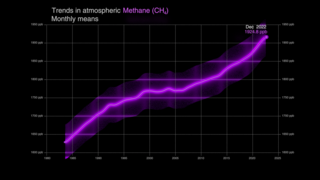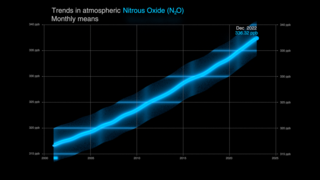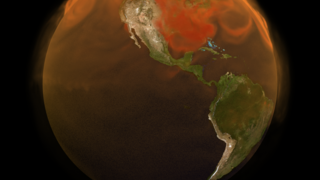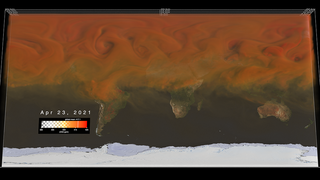Earth
ID: 5110
Carbon dioxide (CO2) is the most prevalent greenhouse gas driving global climate change. However, its increase in the atmosphere would be even more rapid without land and ocean carbon sinks, which collectively absorb about half of human emissions every year. Advanced computer modeling techniques in NASA's Global Modeling and Assimilation Office allow us to disentangle the influences of sources and sinks and to better understand where carbon is coming from and going to.
Atmospheric Carbon Dioxide Tagged by Source
Related
Visualization Credits
Andrew J Christensen (SSAI): Lead Visualizer
Laurence Schuler (ADNET Systems, Inc.): Technical Support
Ian Jones (ADNET Systems, Inc.): Technical Support
Mark SubbaRao (NASA/GSFC): Lead Visualizer
Lesley Ott (NASA/GSFC): Lead Scientist
Helen-Nicole Kostis (USRA): Visualizer
Brenda Lopez-Silva (SSAI): Visualizer
Anansa B. Keaton-ashanti (NASA/GSFC): Visualizer
Laurence Schuler (ADNET Systems, Inc.): Technical Support
Ian Jones (ADNET Systems, Inc.): Technical Support
Mark SubbaRao (NASA/GSFC): Lead Visualizer
Lesley Ott (NASA/GSFC): Lead Scientist
Helen-Nicole Kostis (USRA): Visualizer
Brenda Lopez-Silva (SSAI): Visualizer
Anansa B. Keaton-ashanti (NASA/GSFC): Visualizer
Please give credit for this item to:
NASA's Scientific Visualization Studio
NASA's Scientific Visualization Studio
Science Paper:
Weir, B., Ott, L. E., Collatz, G. J., Kawa, S. R., Poulter, B., Chatterjee, A., Oda, T., and Pawson, S.: Bias-correcting carbon fluxes derived from land-surface satellite data for retrospective and near-real-time assimilation systems, Atmos. Chem. Phys., 21, 9609–9628, https://doi.org/10.5194/acp-21-9609-2021, 2021.
Short URL to share this page:
https://svs.gsfc.nasa.gov/5110
Data Used:
Note: While we identify the data sets used in these visualizations, we do not store any further details nor the data sets themselves on our site.
Keywords:
SVS >> CO2
SVS >> Hyperwall
SVS >> GEOS
SVS >> GMAO
NASA Science >> Earth
SVS >> Earth Information Center
Weir, B., Ott, L. E., Collatz, G. J., Kawa, S. R., Poulter, B., Chatterjee, A., Oda, T., and Pawson, S.: Bias-correcting carbon fluxes derived from land-surface satellite data for retrospective and near-real-time assimilation systems, Atmos. Chem. Phys., 21, 9609–9628, https://doi.org/10.5194/acp-21-9609-2021, 2021.
Short URL to share this page:
https://svs.gsfc.nasa.gov/5110
Data Used:
GEOS Carbon Dioxide
Model - GMAOKeywords:
SVS >> CO2
SVS >> Hyperwall
SVS >> GEOS
SVS >> GMAO
NASA Science >> Earth
SVS >> Earth Information Center

















